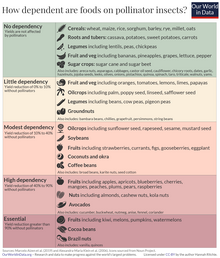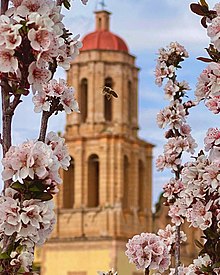Pollination
Pollination is the process of transferring pollen from the stamens to the stigma or receptive part of the flowers in angiosperms, where it germinates and fertilizes the ovules of the flower, making possible the production of seeds and fruits.
Pollen can be transported by different agents that are called pollination vectors. Pollination vectors can be both biotic, such as birds, insects (mainly bees), bats, etc.; as abiotic, for example water or wind.
There is a wide variety of biotic vectors, including Hymenoptera (bumblebees, bees, and wasps), Lepidoptera (butterflies and moths), and Diptera (flies), as well as hummingbirds, some bats, and in rare cases some mice or monkeys.
Some flowers can be pollinated by many vectors, in which case they are said to be generalist flowers in terms of pollinators; or, conversely, they can only be pollinated by one genus or species because the morphology of both the flower and the pollinator have been coupled throughout evolution, in which case flowers are said to be specialists. The specialization of pollination generates a benefit for both the plant and the pollinator, which is why it becomes very efficient since the insect will safely fly to another flower of the same species and deposit the pollen on the stigma of this flower. Among orchids it is common to find great specialization in interaction with pollinators, for example the moth Xanthopan morganii praedicta and the orchid Angraecum sesquipedale.
Antecology is the study of pollination, as well as the relationships between flowers and their pollinators.
Types
Pollen can be transported by physical agents such as wind (anemophilous plants), water (hydrophilic plants), or an animal pollinator (zoophilous plants). The physical and phenological characteristics of anemophilous, hydrophilic, and zoophiles, as well as those of their pollen, are usually markedly different. Zoophilic plants must attract the attention of their vectors with attractive colors and odors, as well as reward them with food or shelter. Different types of pollinators require different types of attractants, so zoophilic flowers have evolved and diversified into a wide variety of types which can be grouped into flower syndromes. The visual beauty characteristically associated with flowers is the effect of their coevolution with insects or other animal pollinators.
In cases where pollination occurs as a result of plant-animal relationships, these relationships are predominantly mutualistic, that is, relationships in which both participants benefit. Unlike the obligatory (properly symbiotic) relationships that exist in nature, most pollination relationships are facultative or optional and very flexible: the disappearance of a pollinator or plant does not necessarily lead to the extinction of the other participant in the interaction, since each one of them has alternatives (other sources of food in the case of the animal, or other species of pollinators in the case of the plant). However, there are some extremely interesting cases of symbiotic relationships between a pollinator and a plant species, such as the fig wasp and the yucca moth.
Evolution of interactions between plants and pollinators
The first fossil record of abiotic pollination (without the help of organic agents) is of fern-like plants from the Late Carboniferous. Gymnosperms show clear evidence of abiotic pollination since the Triassic period.
Some gymnosperms from the Triassic period already show signs of biotic pollination, that is, by animals, in which the fossilized grains have some of the characteristics of pollen grains that are carried by pollinating agents today. In addition, the gut contents, mouthparts, and wing structure of certain beetles and flies suggest that they must have acted as pollinators. The first floral pollination syndromes arose then. The earliest indications of insect pollination are pollen grains from 96 million years ago (Cretaceous). The grains are clumped together in masses, a sign that instead of being carried by the wind, they stick to insects and thus are carried to other plants.
The first evidence of an insect collecting pollen is from the Cretaceous (100 million years) of northern Spain. The researchers used X-ray tomography and were able to observe Gingko pollen grains on an insect preserved in amber.
The association between beetles and angiosperms in the early Cretaceous led to evolutionary radiations of both beetles and angiosperms in the late Cretaceous. The evolution of nectaries or nectar-producing organs marks the beginning of a mutualism between hymenopteran insects and angiosperms.
Bees are good examples of the mutualism that exists between hymenoptera and angiosperms. The flowers provide the bees with nectar (a source of energy) and pollen (a source of protein). When bees go from one flower to another collecting pollen, they also deposit some grains on other flowers, thus causing cross-pollination. While pollen and nectar are the most important rewards for bees and other pollinators, in many cases there are other rewards, such as oils, fragrances, resins, and even waxes. Bees are thought to have originated simultaneously with plant diversification. with flowers or angiosperms. In addition there are cases of coevolution between flowering plants and bee species that induce specialized adaptations. For example the long legs of Rediviva neliana, a bee that collects oil from Diascia capsularis, whose flowers have a long spur. In the course of evolution the spurs of flowers and the legs of bees have been getting longer and longer.
Environmental impacts
In recent years there has been a loss of pollinators. Such losses can have a large economic impact. Possible causes include habitat loss, pesticides, parasitism, climate change, and others. Some researchers think that it is a synergism of all these factors.
In agriculture, climate change is causing a "pollinator crisis." This crisis is affecting crop production and related costs, due to a decrease in pollination processes. This alteration can be phenological or spatial. In the first case, species that are normally found in similar seasons or time cycles now have different responses to environmental changes and therefore stop interacting. For example, a tree may flower earlier than usual, while the pollinator may reproduce later in the year, and thus the two species no longer coincide in time. Spatial disturbances occur when two species that normally shared the same distribution are now moving to different regions in response to climate change.
The structure of plant-pollinator interactions
Wild pollinators often visit a large number of plant species; these, in turn, are visited by many species of pollinators. All these relationships form a network of interactions between plants and pollinators. The structure of these networks presents striking similarities in different ecosystems and continents.
The structure of plant-pollinator networks can have a major impact on how these communities respond to ecological stresses. There are mathematical models that analyze the consequences of the network structure on the stability of pollinator communities. Such models suggest that the specific way in which networks are organized reduces inter-pollinator competition and increases biodiversity. This may even lead to strong inter-pollinator facilitation when conditions are severely disadvantageous. Thus it is possible that the species assemblage of pollinators can survive severe conditions. But it also means that pollinator species can collapse simultaneously if environmental conditions come to a head. Recovery of the pollinator and plant community after such a collapse can be extremely difficult.
Pollination and agriculture
In agriculture, most crops, for example cereals, are anemophilous, that is, pollinated by the wind, or they are autogamous (self-pollinated). Approximately 30% of the world's agricultural crops (for example, many fruits and vegetables) depend on pollination by insects and other animals.
Using pollinators is crucial for global agriculture. Insect pollination (primarily bees) is estimated to be valued at approximately $237-577 billion. It is used all over the world. The food eaten and the role of farmers also depend heavily on pollinators.
90% of flowering plants depend on an insect to pollinate them. This means that for most crops they are a key player. Depending on the plant, there is a certain number of bee colonies per hectare necessary for efficient cultivation. For example, to grow cucumbers you need 2.1 hives per acre. Cantaloupe requires up to 5 hives per acre. Squash and watermelon only need about one hive per acre.
It is a mistake to believe that pollination is a "free ecological service" of nature. Effective pollination needs some resources, for example shelters of pristine natural vegetation and suitable habitats for pollinators. When these are reduced or lost, pollinator activity is limited and adaptive management practices are needed to maintain livelihoods.
Indeed, around the world agricultural and agroecosystem diversity faces the danger that pollinator populations are declining. The main causes of this problem are the fragmentation of habitats, agricultural and industrial chemicals, parasites and diseases, as well as the introduction of exotic species. In California, almond growers routinely import honey bees from other US states to ensure pollination of their crops. This transport can contribute to epidemics.
Contenido relacionado
Eragrostis
Cyperaceae
Burramyidae





